Top 10 Patterns from Chickamauga
A mix of shallow and deep patterns spread out the top 10 finishers
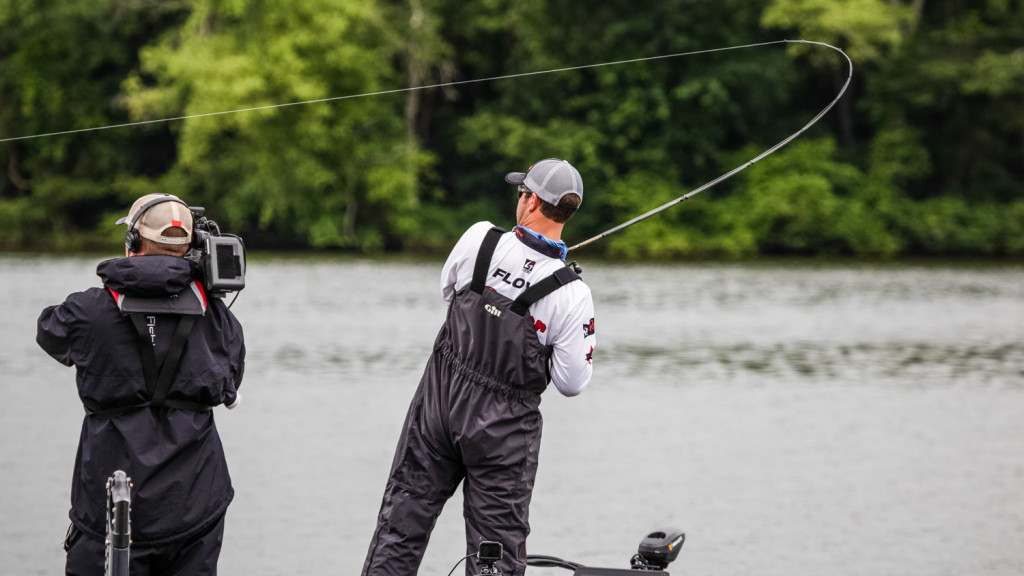
When you put one of the largest and most talented fields of bass anglers on one of the best bass fishing lakes in the country, big things are bound to happen.
The Tackle Warehouse Pro Circuit Super Tournament on Lake Chickamauga became a battle between shallow and deep, with pros on either side catching big stringers of giant bass.
No one caught more of Chick’s famous behemoths than Jacob Wheeler, who scored a 10-pounder on day three and a victory-clinching 8-pounder the final day to take home the win on his home waters. Click here to read about his winning pattern and continue reading below to find out how the rest of the top 10 got the job done.
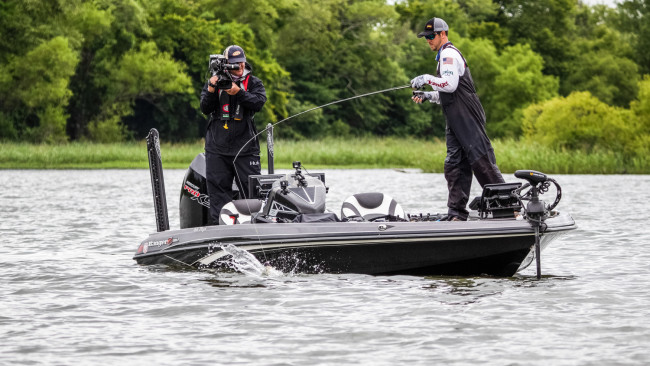
2. Floyd’s shallow bars run dry
In a field with some of the biggest names in the sport, it might be a surprise to see a young rookie’s name in the runner-up spot. Yet, anyone who has followed Cole Floyd’s short career knows it was no fluke.
Floyd has proved himself as an offshore stick by winning the LBL Division of the Phoenix Bass Fishing League presented by T-H Marine each of the last three years. It comes as no surprise, then, that he plied Chickamauga’s offshore spots to earn his second-place finish – though probably not the spots most would associate with “offshore.”
Fishing around the islands in Harrison Bay, Floyd located some shallow bars that came up from 8 feet to 5 feet. The area was a couple hundred yards, and Floyd says it’s normally covered in hydrilla, only this year, it wasn’t – something he figured might play to his advantage.
“I think the fish were pulling up on the edge of that bar where they usually get, but they were not buried down in the grass,” says Floyd. “They were easier to catch. They were exposed.”
It’s there on day two where Floyd nearly had a 30-plus-pound day, as he caught 9- and 7-pounders and lost another he says was close to 10 pounds. All of them came on a 10-inch worm, which he popped along the bottom in an effort to keep it out of the slime that he says coated the bars.
Floyd also sampled a few other offshore spots to catch him limits, alternating between a Strike King 6XD in apple shad, a big flutter spoon and other offshore staples.
It was those bars that were his key to being in contention, and, unfortunately, after day two, he simply didn’t get any more big bites on them.
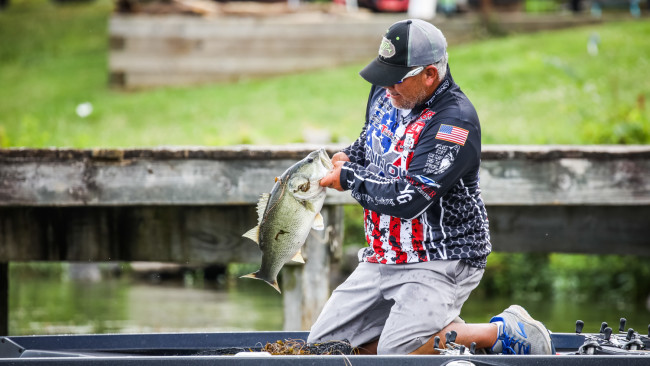
3. Reyes fishes Florida-style up shallow
Chickamauga’s Florida-strain largemouth may be away from their original state, but their behavior is sometimes pretty similar. Knowing that, Jason Reyes fished like he was in Florida throughout the week.
“I had three stretches of grass,” says Reyes of his areas in Chester Frost. “Pepper grass, not hydrilla. I had to stay patient, stay slow, trust what I was doing, and then all of a sudden I’d catch one that was the right one and it’d change the whole day.”
When Reyes says “slow,” he means it. He was almost dead-sticking a Texas-rigged green pumpkin Yamamoto Senko with a nail weight in the tail. He didn’t twitch it or drag it. He just let it lie there until one “walked off with it.” In order to do that, Reyes would simply Power-Pole down and fan cast to bare patches and the edges of isolated clumps.
“The bare spots, the outer clumps, it’s exactly like how you would fish at Toho or Okeechobee,” says Reyes, who would take an hour to go 100 yards because of how slow he was fishing.
The plan worked to perfection on day two when he brought a 27-4 bag to the scales, but as the tournament wore on, the big bites simply dwindled. He only got one big bite – a 7-pounder – on day three, and by day four, the two-hour fog delay cost him precious time that resulted in no big bites.
“With how slow I was fishing, I needed every second I could,” says Reyes. “That [fog delay] hurt, but I did everything I could.”
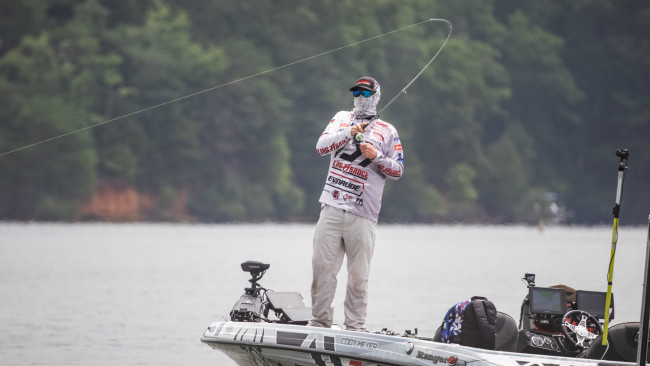
4. Meyer finesses community holes
Community holes get their reputations for a simple reason: The fish are almost always there. Yet, with so many pros hitting them, Cody Meyer really had to downsize to take advantage where others couldn’t.
“I was rigged up like you would for spotted bass,” says Meyer, who hails from California.
His tools were a drop-shot with a Strike King Finesse Worm in various shades of watermelon on an 1/0 Owner Cover Shot hook with a 1/4-ounce Strike King Tour Grade Tungsten weight, plus a Neko rig. For both rigs he used 6- and 8-pound-test Daiwa J-Fluoro fluorocarbon.
“These places are so pressured,” explains Meyer. “You get on these big bars and points and you see hundreds of bass. It takes everything you’ve got to get a bite.”
While many pros had fully planned-out attacks for their ledges, Meyer says he started the tournament just running down the lake hitting any ledge that was open. Eventually, he refined it to about a dozen ledges in 15 to 30 feet of water, with three ledges in particular eventually being key.
“When I left the three areas I was getting bites, I’d struggle to generate anything,” says Meyer. “I kept going back there. I was actually sharing them with Joshua Weaver.
“One thing about the ledges is that I tended to hit the deeper ones in the afternoon. In the morning, they were up on top of the ledges.”
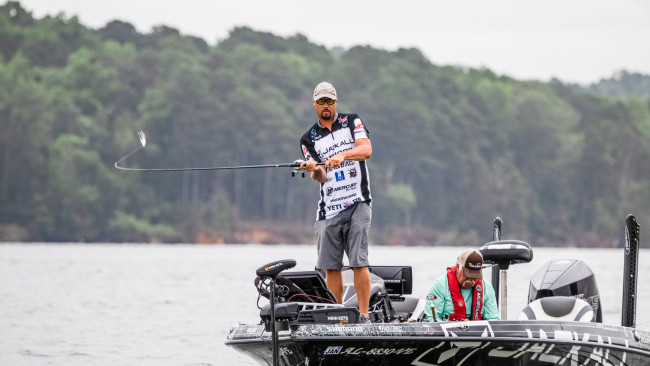
5. Davis bounces between deep and shallow
“If it wasn’t for grass, I wouldn’t be here, but if it wasn’t for deep [areas], I wouldn’t be here,” says Alex Davis about how he made the top five.
While most pros focused solely shallow or deep, Davis was among the few who successfully navigated both, adapting constantly.
“I started offshore on day one, but I never caught anything,” says Davis. “I switched to fishing grass, and then the second day, I fished grass and caught a 6-, 4- and 3-[pounder] before going deep in afternoon. That kind clued me in that I was getting less bites in the grass, but it had big ones.”
In the grass, Davis focused on little pockets of hydrilla – particularly one isolated spot with no other hydrilla nearby for miles, which happened to produce his bigger bites. To catch his fish, he used a prototype Scottsboro Tackle hard swimbait.
Out deep, Davis also threw something a bit different – a Jackal Megalo Doon 1 1/2-ounce spinnerbait with a No. 15 blade on it.
“That is something they haven’t seen,” says Davis of the massive spinnerbait. “It’s hard to throw with all that weight and the blade size, but you can trigger fish that have been beat to death.”
He also mixed in a 6-inch Scottsboro Tackle soft-plastic swimbait in natty light on a 1-ounce jig head, focusing on “off-the-wall places other people wouldn’t look.”
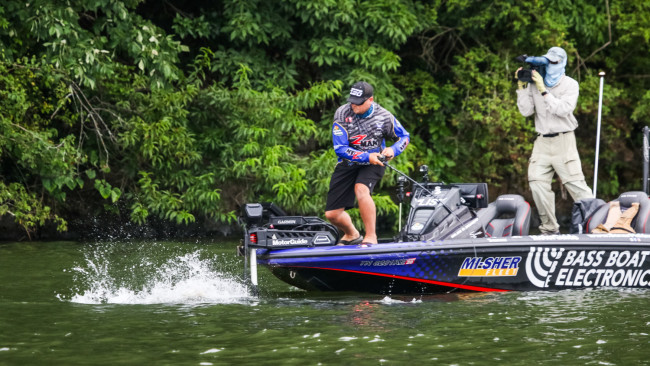
6. Mayflies and bluffs a top combo for Burghoff
Having a pattern all to yourself is a rare thing, especially in a field of more than 200 boats, but that’s exactly what Miles Burghoff found and exploited all the way to a top-10 finish.
“In practice, I noticed the mayflies were hatching; seeing sheddings everywhere down the lake,” Burghoff explains. “There were two bluff walls I focused on because they had shrubs and trees right on the water. Most bluffs, the trees aren’t anywhere near the water. I wanted ones where they were, so the bluegills can pick the mayflies off the trees or when they fell off.”
Like anything, it took a little refining when he began devoting himself to the pattern on day two. Once he did, Burghoff says he put his MotorGuide in anchor mode to start day three, made six casts and caught 18 pounds.
“There was just a pile of fish there, and they were all perfect football 4- to 4 1/2-pounders,” says Burghoff. “They looked like prespawners they were so fat and healthy.”
To catch those bass, Burghoff relied on a Z-man CrossEyeZ football jig in various shades of green pumpkin to mimic the bluegill. He’d cast up against the wall and slowly hop it down, usually getting bit about 25 feet down.
Another great thing about Burghoff’s pattern is that it wasn’t reliant on current, which was a key reason he made the switch after fishing offshore the first day with a 1 1/4-ounce Z-Man/Evergreen ChatterBait Jack Hammer (spot remover) with a Z-Man Razor ShadZ (smokey shad) trailer, which he’d fish like a hair jig; Yo-Yoing it off the bottom.

7. Cox keeps hot streak alive
At this point, any event he fishes on Chickamauga may as well be considered a John Cox charity tournament. The DeBary, Fla., pro made it three straight top 10s on Chick this week, though he did slip up a little bit considering he won the last two (the 2019 Pro Circuit event last May and the Bassmaster Eastern Open a few weeks later).
Of course, there was a moment on day one when Cox felt the streak would end after he ran up the river only to realize a “solid pattern” he found had disappeared with the falling water. Scrambling around, he pulled into the islands around Harrison Bay at the lower end and stumbled upon a special pattern that he inadvertently created himself.
“In practice, I was trolling through this area of pepper grass, and I was behind it when the water was up some,” Cox explains. “Well, I fired the big motor because I didn’t see anything I thought was great and was trying to leave. I was trimmed down, and I accidently cut a lane in the grass.”
At the time, he didn’t think anything of it, but on day one, Cox pulled into that area and caught two 5-pounders on a prototype Berkley frog right in that lane. On day two, he started in the area and again, and despite everything looking great, he could only get bit in that lane, which he admitted he still didn’t realize was there.
It actually wasn’t until the final day that Cox realized why the fish were there, as he says he actually would watch fish constantly swim into the spot. Over the four days, 16 of his 20 keepers came from that one lane in the pepper grass.
To catch them, he relied on a prototype Berkley frog or a Berkley PowerBait MaxScent The General on a wacky rig or Texas rig. He caught the other four keepers up the river on a Dirty Jigs casting jig with a Berkley PowerBait Pit Boss trailer.
“This lake has always been good to me,” Cox admits. “The fish remind me of the ones in the Harris Chain; so much of fishing Florida, but I actually like the cover here better.”
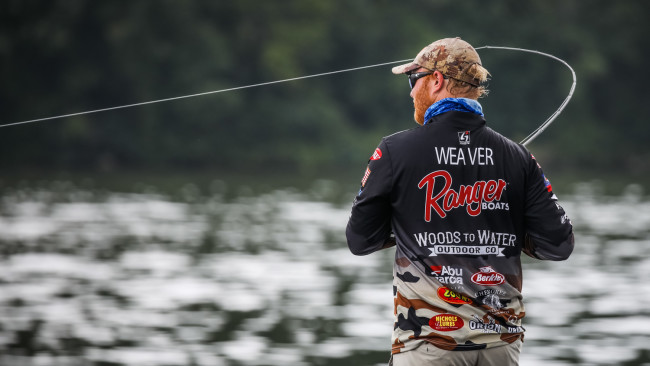
8. Weaver bruised from going big offshore
Pros talk all the time about beating on the fish, but one look at Joshua Weaver’s left side and you’d think he was the one who took the worse beating.
“It feels like I took a couple rounds with Floyd Mayweather to the ribcage,” says Weaver. “My side from my hip to my armpit is totally bruised, and my left bicep is bruised. I’m sure that’s going to take a while to heal.”
It was actually the technique he was using that beat him up, or, more specifically, the lure.
Wanting to throw something different from everyone else out on the ledges, Weaver decided in practice he was going to try out using a Hog Farmer Ledge Hog. Ripping the big blade bait on the bottom was taxing, but the results prompted him to not put it down all week unless he needed a break. Weaver threw it on a 7-foot, 6-inch heavy Abu Garcia Fantasista Premier rod with 20-pound-test Berkley Trilene 100 Percent Fluorocarbon.
When he did need a break or when he wanted to get his limit, Weaver would pick up a drop-shot tipped with a Zoom Z3 in hologram dawn, which he threw on a 7-foot Abu Garcia Fantasista Premier and 8-pound-test Berkley 100 Percent Fluorocarbon. He also mixed in a Ben Parker Spoon and caught most his weight on day two on a topwater when the fish came up schooling.

9. Williams fishes his strengths around docks
If there’s a dock pattern to be had, David Williams will find it.
While he says he caught a few fish on a crankbait and a topwater, most of Williams’ damage was done with a pair of jigs around docks.
If it was cloudy or rainy, he swam a white 1/2-ounce TrueSouth jig with a white Zoom Z-Craw trailer. Then, when the sun came out and the fish moved to the bottom, he changed over to a green pumpkin Queen Tackle jig with a Zoom Z-Craw trailer.
In terms of location, Williams said it was all about covering water and hitting as many docks as possible.
“They seemed kind of schooled up,” Williams says. “I’d hit a little stretch where I’d get two or three in an area. Then, I might go a long time without anything; then another two or three. That’s the way my whole tournament went was those little flurries.”

10. Jones scopes out brush piles
Alton Jones is not one to fish in a crowd, which was a hard thing to avoid out on the main drag of the lower end of the lake. Fortunately, he found something a little more to himself.
“I spent all my time in practice scanning with my Garmins looking for isolated brush piles,” Jones says. “I found about 60 to 70, and I narrowed them down to 12 to 15 that had big-fish potential.”
From there, it was just a matter of “showing up at the right time.” Often, Jones would hit a brush pile at one time of day and see nothing down there with his Garmin Panoptix LiveScope, but then pull up later that day and they’d be there. If they were there, they were usually willing to eat a red bug 10-inch YUM Ribbon Tail worm with a 1/2-ounce weight and a 4/0 hook.
Another thing Jones says helped him was his new BassForce app.
“To be able to look, enter my conditions and see what the top pros agree are the baits and patterns you should pursue; it’s an app I find myself relying on more and more,” Jones explains. “It dials me in mentally to stick with things to catch my fish.”